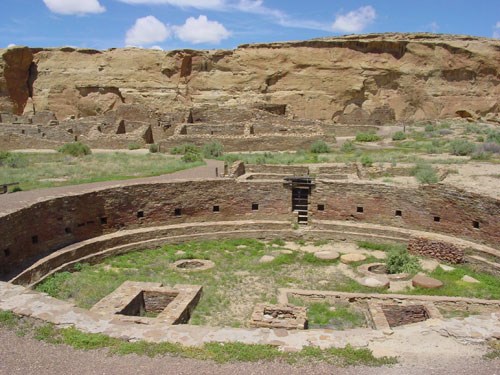
NPS
Ancestral Puebloan refers to the maize agriculturalists who lived across the northern Southwest from the beginnings of cultivation until the coming of the Spanish explorers in A.D. 1540. Cultural traits common to the Ancestral Puebloan peoples include heavy dependence on cultivated foods, the construction of pueblos (multi-room and at times, multi-story, masonry structures), distinctive pottery, and the construction and use of kivas (subterranean ceremonial chambers). However, as in historic times, the prehistoric Puebloan world demonstrated many contrasting traits from west to east.
Ancestral Pueblo people in the western part of the Southwest were primarily dry or floodwater farmers, and developed a set of religious beliefs that emphasize the sacred importance of rain and concentrate an annual cycle of religious ritual on rain making. Ancestral Pueblo people in the east who lived along the Rio Grande River practiced small-scale irrigation agriculture in addition to dry and floodwater farming. Their architecture, ceramics, social organization and religion were distinctly different from their neighbors to the west, and they seem to have placed less emphasis on rain-making ceremonies.
The major branches of the Ancestral Puebloan culture are (roughly from west to east) the: Virgin (along the Virgin river and its tributaries in southern Utah, extreme southeastern Nevada, and northwestern Arizona), Kayenta (in northeastern Arizona and extreme southern Utah), Little Colorado (along the Upper and Middle Little Colorado River), Mesa Verde (centered on Mesa Verde in southwestern Colorado), Chaco (occupying the area in and around Chaco Canyon in northwestern New Mexico, but at its peak extending into southeastern Utah, northeastern Arizona, and southwestern Colorado), and Rio Grande (along the upper and middle Rio Grande).
There is no doubt that modern Pueblo people are the descendants of the Ancestral Pueblo people, although it is sometimes difficult to make specific linkages between the prehistoric cultural branches identified by archaeologists and modern tribes. The great shuffling of populations on the landscape after A.D. 1300 insured that modern pueblo communities would be made up of multiple groups from widespread geographical origins. The Hopi people, for example, are descendants of the Kayenta and Little Colorado branches of the Ancestral Pueblos, but also, of the Mesa Verde and perhaps Chaco branches. Other descendant communities include the Zuni, the Western Keresan speakers of Acoma and Laguna, and the Puebloan communities along the Rio Grande, including Zia, Santa Ana, San Felipe, Santo Domingo, and Cochiti, and Taos, Picuris, Sandia, Isleta, Santa Clara, San Juan, San Ildefonso, Nambe, Tesuque, and Pojaoque.
Last updated: December 7, 2015
